
20. Austria. Trying to learn and analyse the game.
Collection of all my work: https://t.co/07u6bCkRC0
How to get URL link on X (Twitter) App


 Rice just received the ball from White on the right wing, where Arsenal has a 4v4 situation with everyone being marked. The Englishman plays on to Saka with Odegaard providing an underlap.
Rice just received the ball from White on the right wing, where Arsenal has a 4v4 situation with everyone being marked. The Englishman plays on to Saka with Odegaard providing an underlap. 

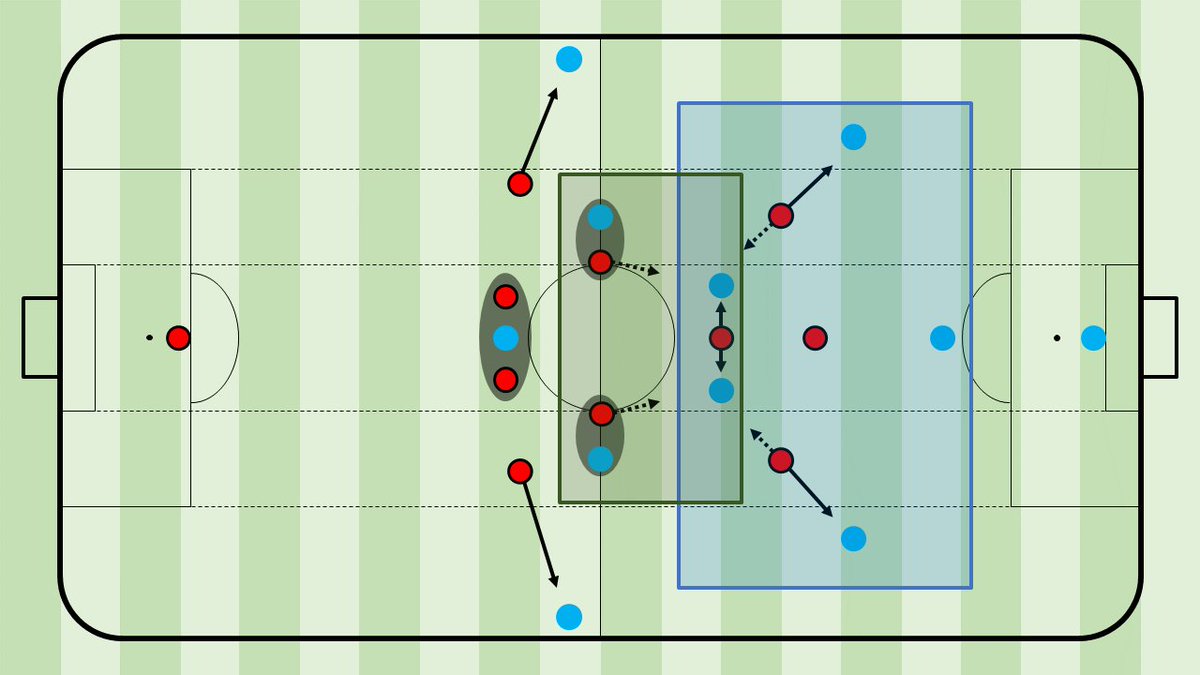



 United’s 4-2-3-1 defensive setup against City’s 3-2-2-3:
United’s 4-2-3-1 defensive setup against City’s 3-2-2-3:




 To begin with, Newcastle pressed incredibly high and looked to disturb Brighton’s deep build-up with extreme aggressiveness. The Magpies used some sort of a 3-2-2-3 shape with a narrow front three and wide 8s against the Seagulls’ 4-2-4 structure. footballxplained.de/brighton-build…
To begin with, Newcastle pressed incredibly high and looked to disturb Brighton’s deep build-up with extreme aggressiveness. The Magpies used some sort of a 3-2-2-3 shape with a narrow front three and wide 8s against the Seagulls’ 4-2-4 structure. footballxplained.de/brighton-build…





 The Foxes regularly found Castagne out wide freely from the build-up with a clipped ball and kept on exploiting ManUtd’s left side in the first 25 minutes.
The Foxes regularly found Castagne out wide freely from the build-up with a clipped ball and kept on exploiting ManUtd’s left side in the first 25 minutes. 







 Dynamical space occupation and rotations:
Dynamical space occupation and rotations: 



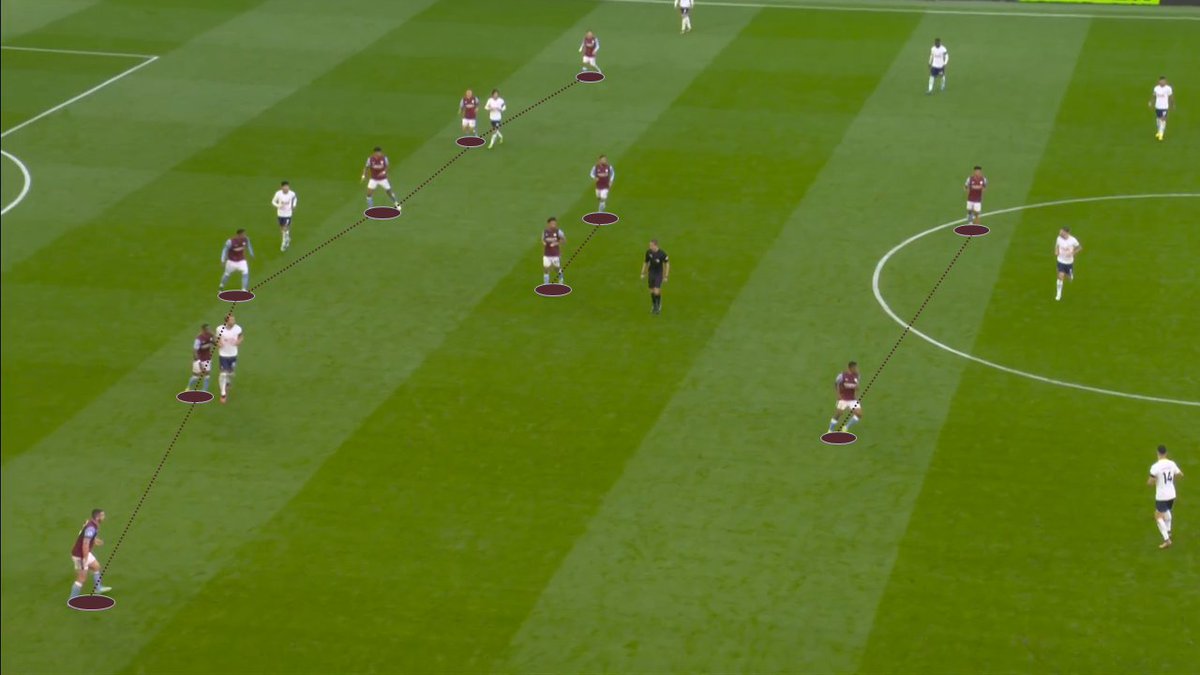
 Emery opted for a back six out of possession with both wingers nearly constantly staying deep besides the fullbacks. Therefore, Aston Villa had one man more in the last line (6v5), meaning there wasn’t an unmarked player, and they weren’t prone to switches.
Emery opted for a back six out of possession with both wingers nearly constantly staying deep besides the fullbacks. Therefore, Aston Villa had one man more in the last line (6v5), meaning there wasn’t an unmarked player, and they weren’t prone to switches. 




 To begin with, France used a lopsided 4-2-3-1 press with Mbappe starting higher, forcing Hernandez to press Molina. Furthermore, Griezmann had a hybrid role, either marking Fernandez, pressing Otamendi or dropping deeper.
To begin with, France used a lopsided 4-2-3-1 press with Mbappe starting higher, forcing Hernandez to press Molina. Furthermore, Griezmann had a hybrid role, either marking Fernandez, pressing Otamendi or dropping deeper. 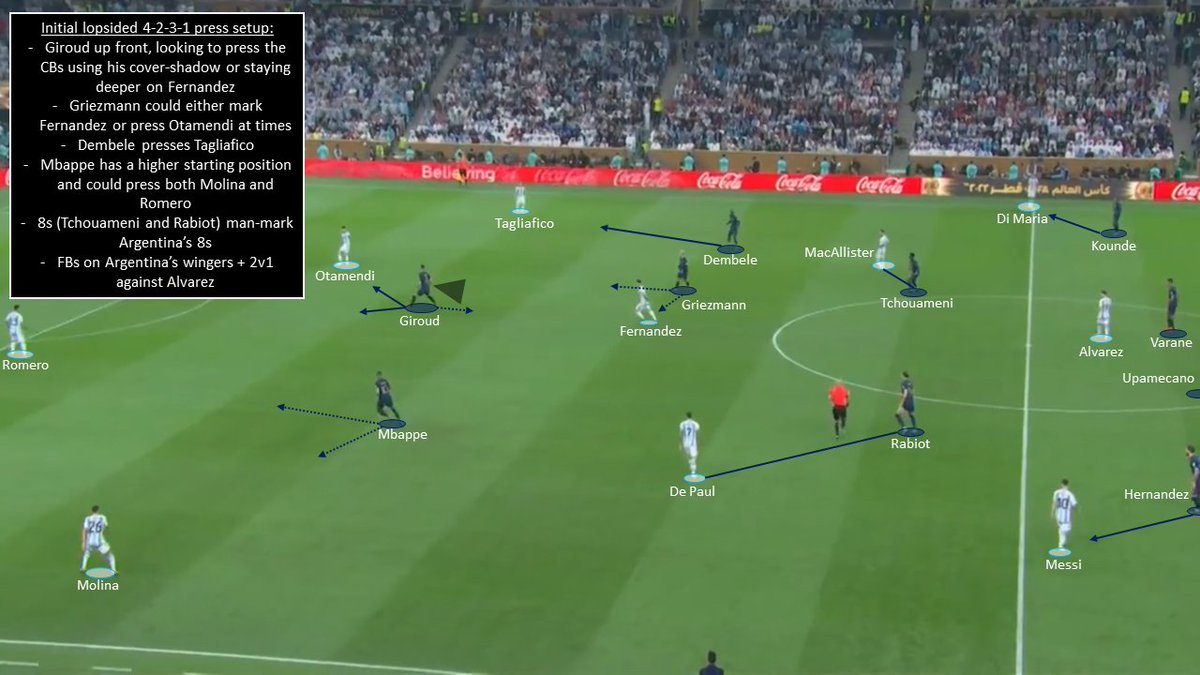






 A key mechanism for Argentina’s progression and chance creation was the vertical rotation between Messi and De Paul. Messi regularly moved deeper, with De Paul advancing to fill the right half-space. This either allowed Messi to create from deep or De Paul to receive higher up.
A key mechanism for Argentina’s progression and chance creation was the vertical rotation between Messi and De Paul. Messi regularly moved deeper, with De Paul advancing to fill the right half-space. This either allowed Messi to create from deep or De Paul to receive higher up. 




 Spain circulates the ball slowly and looks for a free man in the build-up to advance higher up, making use of this unmarked player and arriving with optimal conditions in the final third.
Spain circulates the ball slowly and looks for a free man in the build-up to advance higher up, making use of this unmarked player and arriving with optimal conditions in the final third. 




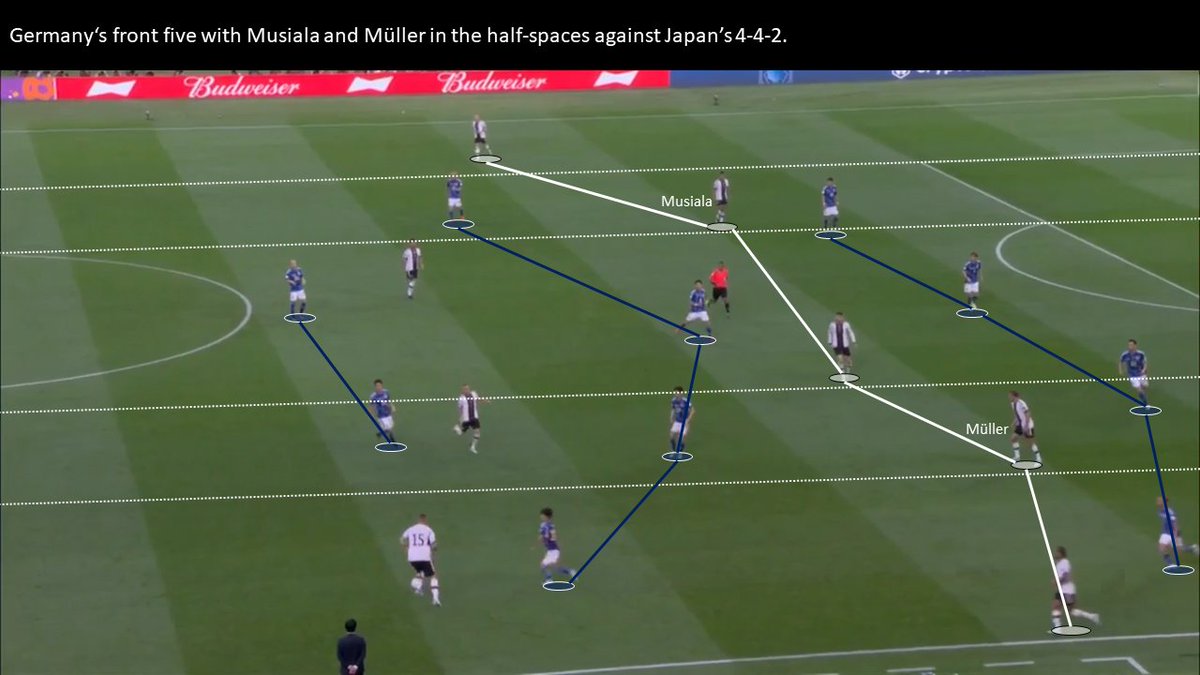 The strikers of Japan looked to restrict passes into Germany’s double pivot by using their cover-shadows. Japan’s 6s stayed in between Germany’s 10s and 6s, allowing them to press the double pivot when a striker pressed a centre back or mark a 10 in deeper zones.
The strikers of Japan looked to restrict passes into Germany’s double pivot by using their cover-shadows. Japan’s 6s stayed in between Germany’s 10s and 6s, allowing them to press the double pivot when a striker pressed a centre back or mark a 10 in deeper zones. 






 Many teams use third man combinations in the build-up to find a free man. And so did Brighton. They often found the free centre back through a player from the double pivot, enabling them to progress higher up more easily.
Many teams use third man combinations in the build-up to find a free man. And so did Brighton. They often found the free centre back through a player from the double pivot, enabling them to progress higher up more easily. 







 This approach worked quite well at times. Especially on Arsenal’s left side, Leeds was regularly able to create a 3v1 situation against Martinelli and won the ball back there, by applying aggressive pressure.
This approach worked quite well at times. Especially on Arsenal’s left side, Leeds was regularly able to create a 3v1 situation against Martinelli and won the ball back there, by applying aggressive pressure. 



 The major aim of football is to score goals. To achieve this, the ball needs to move forward and the fastest way to move the ball forward are passes.
The major aim of football is to score goals. To achieve this, the ball needs to move forward and the fastest way to move the ball forward are passes.

 Especially in the 1st half, Chelsea was regularly able to progress down the right against Salzburg’s asymmetric 4-diamond-2 press. When Kjaergaard (left 8) moved out, Mount was often free, if Salzbrug didn't adjust. When the pass was played wide, Chelsea had a 2v1 overload wide.
Especially in the 1st half, Chelsea was regularly able to progress down the right against Salzburg’s asymmetric 4-diamond-2 press. When Kjaergaard (left 8) moved out, Mount was often free, if Salzbrug didn't adjust. When the pass was played wide, Chelsea had a 2v1 overload wide. 
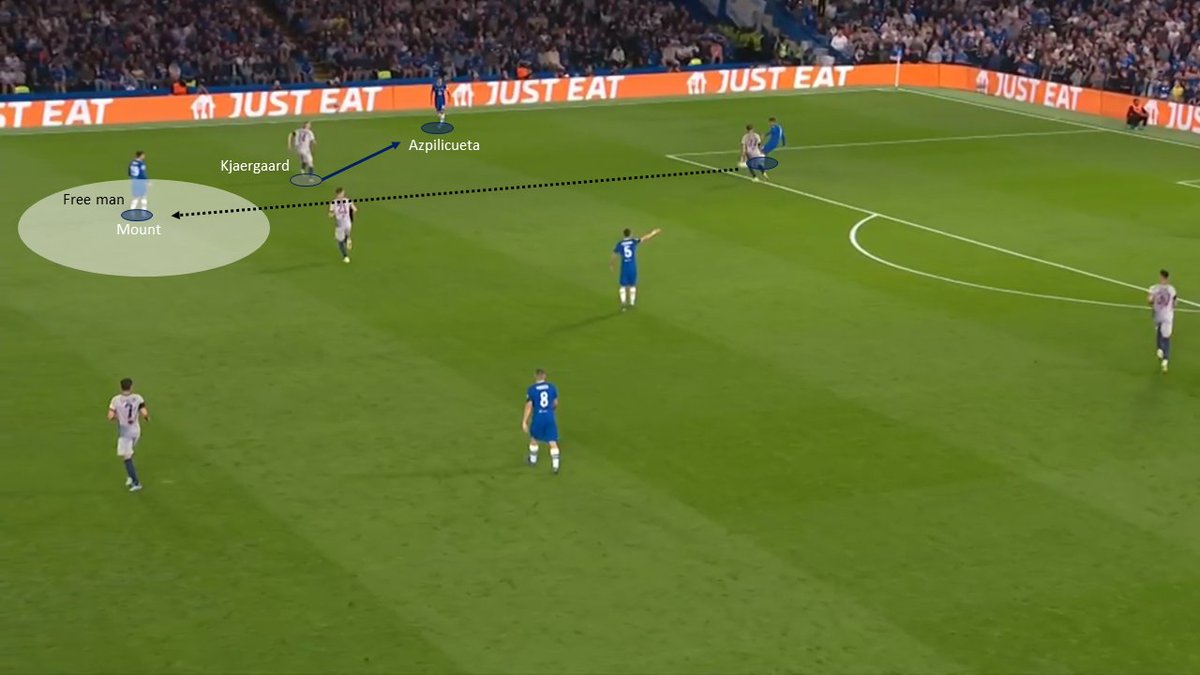





 Switches through short passes have the advantage that the in-possession side can adapt faster to open gaps compared to switches through long balls. Additionally, switches through short passes are faster and the opponent has to react to the change of the ball's position more often
Switches through short passes have the advantage that the in-possession side can adapt faster to open gaps compared to switches through long balls. Additionally, switches through short passes are faster and the opponent has to react to the change of the ball's position more often

 The task of the conventional fullback was to defend. Back in the day, fullbacks were seen as the worst players on the pitch and often used as pressing triggers (e.g.: Sacchi’s Milan). However, in the last couple of years, this view has changed.
The task of the conventional fullback was to defend. Back in the day, fullbacks were seen as the worst players on the pitch and often used as pressing triggers (e.g.: Sacchi’s Milan). However, in the last couple of years, this view has changed.

 RCM dropping deep to help RCB. This dropping movement triggers RB to move up and RM to invert (out of frame), leading to the creation of a 2-3 structure.
RCM dropping deep to help RCB. This dropping movement triggers RB to move up and RM to invert (out of frame), leading to the creation of a 2-3 structure. 

 Liverpool won with the Community Shield their first title of the season against the great rival Manchester City.
Liverpool won with the Community Shield their first title of the season against the great rival Manchester City. 
 “Make the pitch as wide as possible.” This is a quote, which probably every footballer has heard at least once. The goal through wide positioning is to stretch the opponent horizontally and open spaces in between the defenders.
“Make the pitch as wide as possible.” This is a quote, which probably every footballer has heard at least once. The goal through wide positioning is to stretch the opponent horizontally and open spaces in between the defenders. 

 When pressing, most teams try to guide the opponent to a specific area of the pitch to eventually win the ball there and transition to create chances.
When pressing, most teams try to guide the opponent to a specific area of the pitch to eventually win the ball there and transition to create chances.
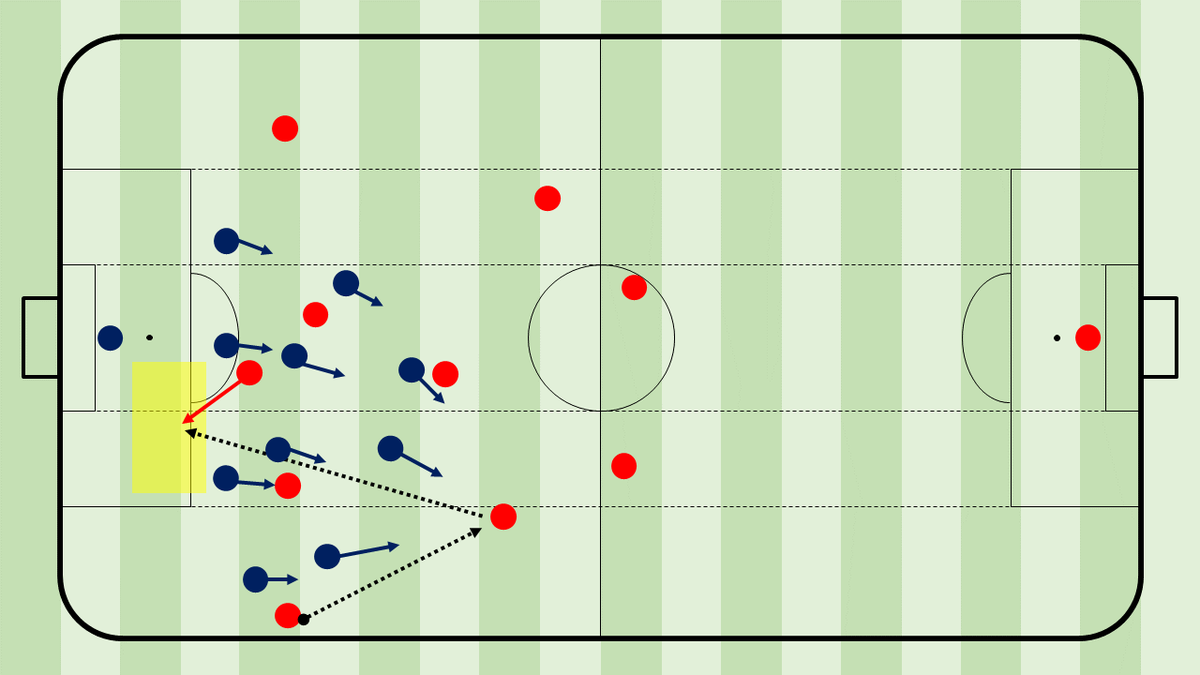
 Major aims in possession are getting in between the lines of the opponent and in behind. However, that’s what most defensive sides try to restrict by using a compact block with little space in between the lines and or a deep block to make it difficult to get in behind.
Major aims in possession are getting in between the lines of the opponent and in behind. However, that’s what most defensive sides try to restrict by using a compact block with little space in between the lines and or a deep block to make it difficult to get in behind.